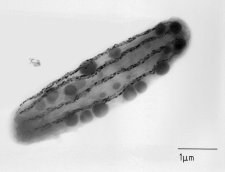Biomagnetism
Biomagnetism concerns the interactions of organisms with the geomagnetic field. Nikolai Petersen established this research in Munich in the early 1980's, when discovering magnetic bacteria in deep-sea sediments. The group is also interested in the biophysical mechanisms of magnetic-field reception in higher organisms, including humans.
More specifically, we are concerned with the following topics:

Discovered in 1975, these microorganisms can be found in most aquatic habitats and are characterized by intracellularly synthesized iron oxide crystals, so-called magnetosomes (grain-size about 50 nm). The crystals, usually consisting of magnetite, are arranged in the form of one or several chains. Such a magnetosome chain can be thought of as a microscopic compass needle, which makes the bacterium swim along magnetic field lines. Our most recent efforts have been directed to understand the environmental influences how and why these bacteria use and sense magnetic fields, to study how they live in time and space in controlled environments and in nature, etc.
Migratory birds and other migrating animals are thought to use the Earth's magnetic field for orientation in their long-distance travels. The biophysical mechanism underlying this is however unknown. We managed to identify a structural candidate for the magnetic-field receptor in the beak of homing pigeons. We have applied the same methodology to zebra fish and trout to localize their magnetic-field receptors).
Since 2013 we have been collaborating with Prof. Christoph Schmitz and Prof. Stefan Milz from the Department of Anatomy II at LMU to map out the magnetic particle distribution in the human brain.
